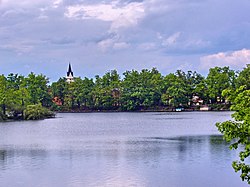Fishponds of the Třeboň Basin
Fishponds of the Třeboň Basin
Třeboň fishpond system | |
|---|---|
 The town of Třeboň seen over the Svět pond | |
 | |
| Coordinates: 49°4′N 14°43′E / 49.067°N 14.717°E | |
| Location | South Bohemian Region, Czech Republic |
| Elevation | 410–450 m (1,350 ft–1,480 ft) |
The fishponds of the Třeboň Basin or Třeboň fishpond system (Czech: Třeboňská rybniční soustava) are a collection of over five hundred fish ponds. They were constructed from the 13th century onwards in the Třeboň Basin area of Bohemia, now the South Bohemian Region of the Czech Republic, with most work occurring between the 15th and 16th centuries, and collectively cover approximately 6,370 hectares (15,700 acres). The individual ponds vary significantly in size, and are connected by a labyrinth of canals, ditches, and streams.
They continue to be used for aquaculture, in addition to flood management, recreation, and biodiversity protection and are currently listed on the
History
Fish ponds are first recorded to have existed within Bohemia in the 12th century, with a carp pond being described in the original 1115
This process was initially slow, but it intensified from the late 14th century, when the Holy Roman Emperor Charles IV commanded the construction of fishponds "so that the kingdom would abound in fish and mist".[2] The ponds resulting from this were often constructed in the spirit of civic competition and were of significant value; a large, 260-hectare (640-acre) pond was considered as valuable as three villages, counting the land and inhabitants.[3] It further intensified during the 15th and 16th centuries when the fish trade was one of the most profitable farming activities in the area.[4]

This period of intensification culminated under
The next major period of development occurred in the late 16th century under Jakub Krčín working for the prominent Bohemian Rosenberg family. Under his direction, many ponds were restored or constructed, including, as a consequence of his construction of a dam on the Lužnice, the Rožmberk Pond which covers 4.89 square kilometres (1.89 sq mi) and is the largest pond in central Europe. Other work conducted under his direction include a canal connecting the Nežárka with the Lužnice called Nová řeka.[1]
Following this development in 1607 the fish-harvest was recorded as being 219 tonnes (241 short tons), but the Thirty Years' War had a significant negative effect on production, and by 1626 the harvest had fallen to just 48 tonnes (53 short tons). Recovery began in 1677, but the process was slow, hindered by a lack of fishermen and managers. This recovery is documented to have been complete by 1751, where a harvest of 260 tonnes (290 short tons) was recorded.[1]
The final major development involved the construction of 36 new ponds under Josef Šusta, collectively covering 413 hectares (1,020 acres) and bringing the total area of the ponds to 6,370 hectares (15,700 acres) in 1908, a value which has changed little since.[1]
The ponds are currently owned by Rybářství Třeboň a.s., having been owned by the House of Schwarzenberg until 1920, and currently produce approximately 2,900 tonnes (3,200 short tons) of fish per year, with the vast majority of this total being carp.[4]
Current uses
From their beginning as an effort to drain the swamps in order to obtain farm land, the ponds have served a wide variety of functions. Today, these include aquaculture,
Biodiversity

The ponds serve an important role in ensuring biodiversity,
However, this role is threatened by the intensified farming since the end of the Second World War; it has caused the destruction of some of these environments, and it has caused eutrophication throughout the region. These issues are exacerbated by the choice to harvest fish from April to June, as this coincides and disrupts the bird breeding season.[1]
Water management
The broader fishpond system has a water catchment across the entirety of the Lužnice River, including both the Czech and Austrian portions, resulting in a total catchment size of 1,700 square kilometres (660 sq mi), and when this region experiences floods the ponds perform a secondary function of water management during floods.[4]
The fishponds have a
UNESCO status
The ponds are proposed for inclusion in UNESCO World Heritage sites,
See also
References
- ^ ISBN 2-8317-0386-7.
- ^ ISBN 978-0-8138-2163-4.
- ISBN 978-0-8138-2163-4.
- ^ .
- ISBN 80-86434-00-1.
- ISBN 80-86434-10-9.
- ^ "Tentative Lists submitted by States Parties" (PDF). Baku, Republic of Azerbaijan. 17 July 2019. p. 19.
